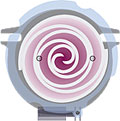
FIGURE 1.
FEDERAL MANDATE
Every central split cooling system manufactured in the United States today must have a SEER of at least 13. Federal law as of Jan. 23, 2006 mandated this energy requirement. Also, with the phaseout of R-22 just around the corner, manufacturers of HVACR equipment are looking for energy-efficient methods to apply to their equipment to meet these new energy requirements.SEER is calculated based on the total amount of cooling (in Btu) the system will provide over the entire season, divided by the total number of watt-hours it will consume.
Higher SEERs reflects a more efficient cooling system. This federal mandate impacts 95 percent of the unitary market in the United States, which are about 8 million units at the time of writing. Because of this new federal mandate of 13 SEER, most air conditioning and heat pump manufacturers are looking for more efficient evaporator and condenser designs, more efficient compressors like the scroll compressor, and more efficient fan motors, along with more sophisticated control systems to meet this new energy-efficiency requirement.

FIGURE 2.
NEW TECHNOLOGY IN SCROLL COMPRESSORS
A new technology in scroll compressor design allows the compressor to have a two-step modulating capacity of either 67 percent or 100 percent. The addition of an internal unloading mechanism in the scroll compressor opens a bypass port or vent at the end of the first compression pocket. This internal unloading mechanism is a direct current (dc) solenoid controlled by the second stage of the conditioned space thermostat in either the heating or cooling modes.The dc solenoid, which is controlled by a rectified external 24-V alternating current (ac) signal, moves a slider or modulating ring that covers and uncovers the bypass ports or vents. The compressed gas is then vented into the beginning of a suction pocket within the scroll. When the bypass or vent port is opened by deenergizing the dc solenoid, the effective displacement of the scroll is reduced to 67 percent. (See Figure 1.)
When the dc solenoid is energized by the second stage of the conditioned space thermostat, the bypass ports are blocked or closed and the scroll is at 100 percent capacity. (See Figure 2.)
Again, this opening and closing of the bypass ports or vents are controlled by an internal electrically operated dc solenoid. The unloading and loading of the two-step scroll compressor is done while the compressor’s motor is running without cycling the motor on and off.
The compressor motor is a single-speed, high-efficiency motor that will continue to run while the scroll modulates between the two capacity steps. Whether in the high (100 percent) or low (67 percent) capacity mode, the two-step modulating scroll operates like a standard scroll compressor.
As mentioned earlier, the internal dc solenoid in the compressor that operates the internal unloading mechanism is energized by the second stage of the conditioned space thermostat. It is expected that the majority of run hours will be at low capacity (unloaded at 67 percent). It is in this mode that the solenoid is de-energized.
This allows the two-stage thermostat to control capacity through the second stage of the thermostat in both cooling and heating. An extra external electrical connection is made with a molded plug assembly that contains a full wave rectifier to supply dc to the solenoid-unloaded coil. The rectifier is actually located in the external power plug on the compressor.
Not only is this modulating compressor up to four times quieter than a reciprocating compressor, it will allow up to 60 percent greater energy efficiency compared to a 10 SEER system. It more or less delivers steady state cooling and eliminates the peaks and valleys of temperature extremes within the conditioned space caused from compressor cycling. It will put a cooling system in the 15 plus SEER market and is a popular sell-up for many contractors who want to promote improved comfort and efficiencies for residential air conditioning systems.
Publication Date:07/02/2007


Report Abusive Comment